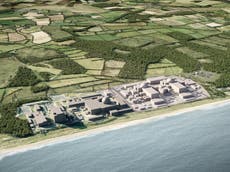Investors ‘shun’ Sizewell C nuclear power station project
Legal & General follow Aviva Investments in giving thumbs down to nuclear power project, reports claim

Your support helps us to tell the story
From reproductive rights to climate change to Big Tech, The Independent is on the ground when the story is developing. Whether it's investigating the financials of Elon Musk's pro-Trump PAC or producing our latest documentary, 'The A Word', which shines a light on the American women fighting for reproductive rights, we know how important it is to parse out the facts from the messaging.
At such a critical moment in US history, we need reporters on the ground. Your donation allows us to keep sending journalists to speak to both sides of the story.
The Independent is trusted by Americans across the entire political spectrum. And unlike many other quality news outlets, we choose not to lock Americans out of our reporting and analysis with paywalls. We believe quality journalism should be available to everyone, paid for by those who can afford it.
Your support makes all the difference.A planned nuclear power station at the Sizewell facility on the Suffolk coast has suffered a significant setback after major investors have ruled out providing funding for the £20bn project.
Legal and General Capital - the investment arm of the financial services company - has said it is not backing French energy firm EDF’s Sizewell C plans, which involve building two new reactors at the site.
Responding to enquiries by The Independent, an L&G spokesperson said: “As we transition to a net zero carbon world, Legal & General Capital is playing an important role in investing in renewable infrastructure and clean technology across low-carbon heat, transport, and power generation.
“To support this, we regularly monitor the proposed financing arrangements of any large scale, strategic UK infrastructure project. However, while we explore all options and do not usually comment on prospective investment intentions, I can confirm that Legal & General Capital is not currently in discussions with Sizewell C.”
The company has signalled its support for other green initiatives, including a joint venture with EDF in which it is investing in a company making charging points for electric vehicles.
The decision not to back the nuclear power station comes just days after another major potential investor - Aviva Investors - suggested they had environmental and other concerns about nuclear power.
In response to queries from investors, Aviva Investors said: “As you are probably aware, the UK government is looking at expanding nuclear capacity as part of its efforts to achieve net-zero emissions by 2050.
“We consider the potential ESG (environmental, social and corporate governance) impact in all of our investment decisions. However, the ESG impact of nuclear is far from clear at this time and we are not actively involved in any such investments.”
Though the government has signalled support for more nuclear power stations in the UK to help the country meet its legally-binding 2050 net zero emissions target, critics have argued that another hugely expensive nuclear power station is not the answer.
Of six potential nuclear power station sites originally identified a decade ago, three have seen contractors pull out and only one is under construction - at Hinkley Point in Somerset.
Last month, Hinkley Point’s developers said costs had gone up by £500m and the power plant was to be delayed by another six months.
Over the last five years, the costs of building the controversial power station have risen by £5bn, driving it up to almost double what it was originally planned to cost in 2008, while it is now forecast to begin generating electricity in 2026 - almost a decade later than the original start date of 2017.
The UK government has guaranteed EDF £92.50 for each megawatt hour of electricity produced - a price which will help EDF recoup the rising cost of the project, but one which is at least twice as high as the cost of wind-generated power, offering poor value to consumers.
Wind power generation cost as low as £44 per megawatt hour at auction last year.
Despite the huge cost and slow pace of the Hinkley Point C project, the UK government is also considering spending billions of pounds of taxpayers money on initiating a plan to build as many as 16 small nuclear reactors which would also contribute to the national grid.
But as renewable power generation surges, enormous nuclear projects and the potential risks they pose to the environment may look increasingly unappealing.
Just over a decade ago, wind power made up 3 per cent of the UK’s electricity. Turbines now supply almost a quarter of the electricity used in Britain, and on windy days have provided up to 59.9 per cent of all electricity.
L&G’s boss Nigel Wilson described Hinkley in 2016 as a “£25bn waste of money”.
He told BBC 5 live: “The world is moving towards clean green and cheap energy. Solar, wind will play a much more important role. Hinkley is probably the most expensive energy we can think of right across Europe. That’s really bad for society.”
Campaign group Stop Sizewell C have said building the power station “will have a devastating impact on this unique and magical place. There are better alternatives than Sizewell C in the fight against climate change and to avoid damaging protected habitats.”



Join our commenting forum
Join thought-provoking conversations, follow other Independent readers and see their replies
Comments